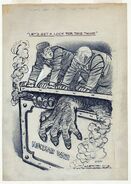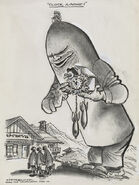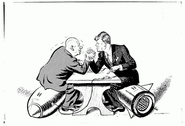Historical Background[]
In August 1945, the United States dropped two atomic weapons named "Fat Man" and "Little Boy" on the cities of Nagasaki and Hiroshima, Japan. When the bombs struck the surface, the world was introduced to the most powerful weapon ever created by humankind. These atomic weapons killed two ways: the magnitude of the blast and resulting damage, and the nuclear fallout that followed. With the creation of such a powerful weapon, countries across the nation rushed to create their own atomic weapon. In 1949, the Soviet Union finished their own atomic weapon. This sparked a massive stockpile in the creation of atomic weapons from both the United States and the Soviet Union. This stockpiling of nuclear weapons is referred to as the arms race (Winkler, 1984). Also, this fueled a power struggle between these two world powers who had different political perspectives. In turn, this struggle was filled with tension that resulted in a feeling of constant fear of nuclear peril. With that being said, both countries prepared their citizens for a nuclear war. In particular, the United States relied upon using pamphlets, brochures, newspaper articles, and diagrams to control its fear and provide directions on how to be prepared for attacks. The United States Federal Civil Defense Unit challenged American citizens to be personally responsible for their own preparedness for an attack (Tunc, 2014, p.182). In turn, counties, communities, and townships all created plans on how to survive a nuclear fallout. A major theme prevalent in the messages being sent by the civil defense department was that survival is a choice if one chooses to follow the steps given (Jacobs, 2010). Another major theme was that the social leader was in charge during an attack. These social leaders were teachers or the government and it was their job to initiate the steps for survival. Furthermore, it was their duty to maintain social order and society itself during a time of crisis (Jacobs, 2010).
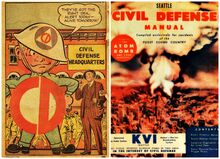
Mr. Civil Defense Talks about Disaster, 1951 Civil Defense Manuel. http://www.retroarama.com/2013/04/nuclear-jitters.html
Aimed Towards Children []
The experience of children during the cold war was far different from their parents. While their parents were concerned with the well-being of their health and families, children feared the loss of a future they could grow into (Jacobs, 2010).Also, in schools children were being told not to be passive victims of the attack. Furthermore, they were taught to see America as the "good guys", fighting for a noble cause. With that being said, many of the civil defense information being targeted at children was calling the war an "adult war". In turn, the pamphlets and brochures featured kid-friendly characters that resonated with children. Also, these characters were created (Bert the Turtle, Mr. Civil Defense) to demonstrate adult-like qualities. The characters demonstrated wisdom, poise, and an ability to be self-reliant. Furthermore, a subtle theme throughout the pamphlets and information was adults will help you, but if the adults are not around the children are on their own to survive a nuclear attack. In turn, the government was preparing the children for the worst scenarios and they were trying to lead the children of that generation to the realization that days could be limited if they are not completely prepared. Also, in a grim sense, if their family did not survive an attack they would be thrust into a leadership position(Jacobs, 2010).The government really made an extended effort to target the children with characters that resonated with them and showcase to the children what they expected out of them.
Directed Towards Families[]
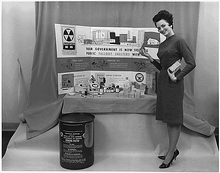
Picture of all the supplies recommended for a fallout shelter in 1961 (Lawlor, 2000).
During the cold war era, there was a plethora of material designated towards children, but there was more material designated towards families and adults. It began in 1950 with the mass printing of "Survival Under Atomic Attack". That was printed to help the public anxiety of a Soviet Union attack. "Survival Under Atomic Attack", created the foundation for instilling a perspective amongst the general population that they need to be self-reliant and the military may not be able to protect everyone.The United States government challenged the American people to be prepared for anything. Furthermore, it was not long before individuals began expanding on the Duck and Cover initiative that began in the early 1950's. With more research being published about the power of these weapons. The material began being focused on creating fallout shelters then simply taking cover behind a nearby table. For example, Good House Keeping Magazine carried a full-page editorial in November in 1958 which urged the building of family shelters, also a Pennsylvania Newspaper showed the biblical ark with the caption, "They laughed at Noah" ( Winkler, 1984). The theme of self-reliance became more than just knowing the steps to potentially survive but actually invest in home fallout shelters and large amounts of specific supplies. In the massively produced pamphlet called Facts about Fallout (1955), the pamphlet discusses what type of shelter work the best against a nuclear attack. Also, this pamphlet suggests having enough supplies in your shelter to last a couple days. With American scientists, it became a controversy of whether fallout shelters were useful or not (Lowlor, 2000). The Federal Civil Defense Unit continued to encourage citizens to build them individually or have their community have them in place. By the end of 1960, it was estimated that there was a million family fallout shelter nationwide (Winkler, 1984). With the increase of fallout shelters being built, the Federal Civil Defense Unit produced materials that gave recommendations for different items needed to be stockpiled. Overall, a constant theme with all the materials being produced by the Federal Civil Defense Unit for families was be prepared for the worst and do your part to protect your family. Furthermore, they encouraged people to be self-reliant for themselves and their family (Jacobs, 2010).
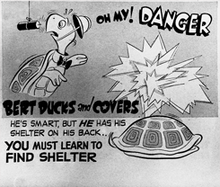
"Bert The Turtle" Cartoon Booklet was part of the "Duck and Cover" campaign aimed at children 1951
Duck and Cover[]
By far, one of the most memorable brochures/series from the American cold war era was that of Bert the Turtle or also known as Duck and Cover. This brochure also had a film that went along with the same concept. Furthermore, it was sent to schools all across the country.Duck and Cover was part of the response to the Soviet Union's nuclear weapons and the first Soviet test detonation in late 1949 (Escalona, 1962). The United States government was aware that an attack from the Soviet Union could happen at any moment. With that being said, children would need to be aware of what steps to take in order to survive. Thus, the purpose of Duck and Cover was to instruct children how to a potentially survive a nuclear attack without adult assistance (Winkler, 1984). The first page displays Bert the Turtle as a mild manner citizen walking on a path when a youthful monkey hanging on a tree drops a stick of dynamite. The next page showcases Bert the Turtle taking shelter in his shell as the dynamite explodes. All the while, at the bottom of the page the brochure is raving about the quick thinking of Bert the Turtle. From that point, the brochure discusses how he has his shelter on his back, but you (referring to the children) must learn to find shelter for yourselves. From there, the brochure shows relatable situations to children such as: crossing a street and what to do when they hear a fire alarm. Quickly, the brochure transitions to a view of a nuclear explosion and the devastation it causes. The rest of the brochure includes instructions on how to Duck and Cover and also showcases different examples of children taking cover in their current situation.
Bert the Turtle was created to resemble an adult while the monkey he encounters is depicted as a reckless kid.Yet, the character which the children resonate with is the self-reliant adult and not the reckless ape. For kids growing up in the cold war era "duck and cover" was a showcase of adult business designated for children. The message sent to the children through "duck and cover" was not just an instructional guide to using this technique, but actually reinforcing the idea of being self-reliant in the cold war era (Jacobs, 2010). Overall, this brochure was one of the most memorable uses of media during the cold war era.
http://contentdm.unl.edu/cdm/singleitem/collection/comics/id/39/rec/1 -direct link to the pamphlet of Bert the Turtle want to make it hyperlinked?
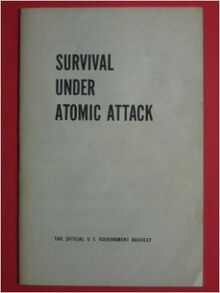
Survival Under Atomic Attack was the first pamphlet created by the United States Federal Civil Defense Unit in 1950.
Survival Under Atomic Attack[]
(https://www.orau.org/ptp/Library/cdv/Survival%20Under%20Atomic%20Attack.pdf)
Survival Under Atomic Attack was the first civil defense pamphlet that was sent to over 20 million households nationwide in 1950 (Jacobs, 2010). This was an extremely memorable artifact from the cold war era. Due in large part to its first page, that stated,
"You can Survive, you can live through an atom bomb raid and you won't have to have a Geiger counter, protective clothing, or special training in order to do it. The secrets of survival are: know the bomb's dangers. Know the steps you can take to escape them"(Winkler, 1984).
After the first page, the pamphlet uses a question header, then proceeds to answer the question. From there, a section of myths are debunked, survival tips are stated, and another question-answer section concludes this 32- page pamphlet. This pamphlet was used to control public anxiety over the prospect of a soviet attack and the potential destruction of everything people have come to know. This pamphlet was directed completely to adults. The wording is precise and uses a higher vocabulary than other pamphlets by the Federal Civil Defense Unit. It utilized no pictures just precise content. Again, the major themes of all of the material sent out by the Federal Civil Defense Unit continue to appear, these themes being self-reliance/prepared and take control of the situation if this notion presents itself. A subtle theme throughout this pamphlet was that the military may not be able to protect you, thus it is up to the individual to fend for themselves if the situation is presented. It was not meant to dismiss the military, but instead, be honest with the citizens about the threat that lies across the ocean. Furthermore, this was just the beginning of different government-funded material that was widely produced during the cold war era (Jacobs, 2010).
Herbert Block (Herblock)[]
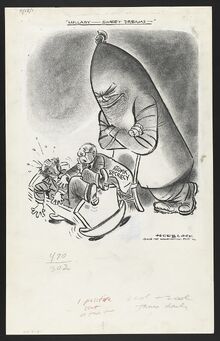
"Lullaby--Sweet Dream--"by Herbert Block (1956) https://www.loc.gov/item/2012633529/
While the United States Federal Civil Defense Unit was providing pamphlets and brochures for the general public showcasing how individuals have the “choice” to survive nuclear fallout, some media outlets were feeding counter-culture with alternative views of the social issues. Herbert Block was one of the main contributors to the counter -culture who displayed the American government of having too much political hypocrisy and hubris within their political cartoons (Lamb, 2013). Herbert Block's cartoon illustrations were an important media outlet for offering an alternative perspective to the masses. His political cartoons were a challenge to the constant material being produced by the Federal Civil Defense Unit. For example, in his political cartoon named "Lullaby--Sweet Dream--" he depicts Mr. Atom (a major character in many of his illustrations during this time period) and a man labeled atomic secrecy in the sleeping quarters of a gentleman. The illustration shows a man in a state of terror while atomic secrecy is shown trying to mollify the individual. Of course, this political cartoon is a jab at the Federal Civil Defense's pamphlets and brochures that are attempting to mollify the general public. Overall, Herbert Block was quick to dismiss the idea that cartoons could only be passive chuckles, instead he instilled his cartoons with deep reflection (Abraham,2009). In turn, he was challenging the masses to really articulate for themselves the social issues of the cold war era. Furthermore, he wanted the masses to not blindly follow what Federal Civil Defense Unit was saying, but for the masses to understand what they are actually following. For that reason, the work of Herbert Block and other members of the counter-culture are important to mention when discussing fallout awareness media.
Link to entire collection: http://www.loc.gov/exhibits/herblock/exhibititems.html
Targeting Specific Professionals[]
In addition to the need of informing the general public about the threats and risks of nuclear war, specific professions also were targeted by the Department of Civil Defense. Pamphlets, displays, and other material were created with the purpose of providing information for professionals to carry out their duties even during the unthinkable environment of atomic destruction.
Industry[]
“As an executive, you are responsible for seeing that your company continues to exist and to function. In the narrowest sense, this responsibility is directly to the stockholders-the owners. More broadly, you have a responsibility to your employees, their families, the community, and the nation” (Nuclear Attack and Industrial Survival, 1962).
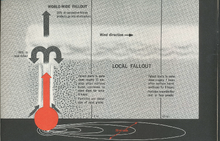
A fallout diagram in Nuclear Attack and Industrial Survival.
Industry professionals were expected and encouraged to work with the federal government to prepare a response plan for nuclear war. As part of this preparation, a variety of information was provided as to the nature of radioactive fallout, which included detailed visual aids and graphs. The materials present a very serious take on the need for fallout protection, outlining the differences in fatality percentages with and without shelter (Nuclear Attack and Industrial Survival, 1962). Industrial companies were also informed through displays that they could work with the Department of Civil Defense to survey options for creating fallout shelters, provided supplies for those shelters, as well as develop protocols for factory shutdowns and training for such situations (Civil Defense Museum). Seeing the benefits of tapping into the existing structure of industries in case of nuclear war, the Department of Civil Defense utilized a variety of visual media to reach out to industry leaders. The materials clearly outlined the serious nature of the threats,and encouraged cooperation with the Department to optimize preparation plans.
Architects and Engineers[]
Preparing for nuclear war also brought with it new considerations for designing and building new structures. Architects and engineers needed to be informed of these new considerations, and instructed on how to design and build fallout protection structures for a variety of structures. One publication by the Department of Civil Defense detailed the process of accessing fallout protection of a location, including the numbers necessary to calculate the impact of factors such as multiple floors of a building or the thickness of floors (Fallout Shelter Surveys 1960). Fallout Shelter Surveys also provided additional information on the ventilation, space, and sanitary needs of a fallout shelter depending on the number of occupants (1960). As with the other materials targeting professionals, the booklet dispenses with platitudes concerning the threats of nuclear war and the needs of a fallout shelter:
“The standards suggested in this guide are not meant to obviate the sound professional judgment that individual cases will require. However, it is important when considering fallout shelter standards to keep in mind that survival is the paramount issue and that comfort is secondary.” (Fallout Shelter Surveys 1960)
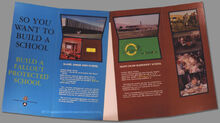
A display demonstrating examples of new schools with integrated fallout shelters (Civil Defense Museum)
Materials were also produced to provide information on addressing specific architectural needs for fallout protection. One notable example is a display demonstrating how to design fallout shelters within new schools without interfering with the form and function of the buildings (Civil Defense Museum). Recognizing that these architects and engineers needed additional information to meet the rising demands for fallout shelters in new buildings, the government addressed these needs by providing detailed numerical data and graphs to utilize in their designs, as well as illustrating that such considerations need not interfere with aesthetic considerations.
Morticians[]
A grim reality of the specter of nuclear war is the inevitable death such an attack would cause. However, even after death, the remains of those who perished in atomic war would still need to be dealt with. Thus, specific materials directing the efforts of morticians in a post-nuclear environment were also drafted. However, unlike materials created for the public, or even other professionals, these materials were much more realistic and sober concerning the realities of atomic war. A notable pamphlet, titled Mortuary Services in Civil Defense, "...is essentially a manual for disposing of extremely large volumes of (radioactive) corpses” (Wellerstein 2012). Early on, the writing is brutally honest about the realities of such an unthinkable situation: "Disposal of bodies as nearly as possible in accordance with normal customs and religious rites will be a major contribution to morale, but such methods may be impossible” (Mortuary Services 1956).
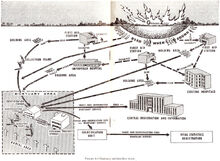
A rather morbid example of the system for dealing with bodies following a nuclear attack.
The pamphlet notes that normal methods of identification might be impossible due to the level of burns and injury to the deceased (Mortuary Services 1956). This source includes detailed diagrams for the transfer and disposal of the bodies from nuclear attack (see example at right). The overall tone of this pamphlet addresses serious concerns for a serious undertaking, and takes no time to dress up the topic with optimistic rhetoric or gentle address of the problem at hand. It addresses the problem of the dead following a nuclear attack matter-of-factly, expecting that those familiar with such realities will have no need for pretense. Wellerstein notes this, stating:
"It’s hard to claim that this particular pamphlet would make anyone feel sanguine about the effects of nuclear weapons. Of course, this particular pamphlet wasn’t really designed for the “general public” — it was a relatively narrow technical manual." (2012)
Business Professionals[]
“All units placed at the 4700-ft range were recovered with the records Intact and In excellent condition. An insulated file cabinet placed In the open had a 3-in. dent in the side plate of the door housing. Otherwise the unit and its contents were in excellent condition. The uninsulated file cabinet placed on the second floor of the brick-veneer structure (Fig. 3.16) and the steel shelving unit holding the document boxes in the basement or the same structure (Fig. 3.17) were damaged by debris. The file cabinet was considered unusable. The top two shelves of the shelving unit were knocked down as the structure collapsed onto it.” (Effects of a Nuclear Explosion 1956)
In spite of the apparent absurdity of such a petty consideration, even the preservation of important business records was taken into consideration by the federal government. Effects of a Nuclear Explosion on Records and Records Storage Equipment details the results of a nuclear test where documents were deployed at varying distance from a nuclear detonation at varying levels of protection, in order to determine methods to preserve records following a nuclear attack (1956). However, it is questionable whether such information would be of much concern after the large scale destruction of nuclear attack, particularly in the early days. Nonetheless, such concerns were considered worth study and publishing in the service of civil defense.
Overview[]
Overall, civil defense pamphlets are very much a product of their time, shaped by the concerns of the era and the audiences targeted by them. In spite of the later misinterpretation by many that civil defense was foolish, these efforts were very much a product of a need for information and coordination seen in their time, though events that followed (including the slow deescalation of nuclear tensions) would, in the years that follow, turn them into amusing relics (Greenberg 2003). Nevertheless, analyzing these materials can help us to understand the mindset of Americans during the early Cold War, and how they saw the threat of open war with the Soviet Union.
Link To Facts about Fallout www.archives.gov/education/lessons/fallout-docs/
Sources[]
Tunc, T. E. (2014). Eating in Survival Town: Food in 1950s Atomic America. Cold War History, 15(2), 179-200. Retrieved March 2, 2016.[]
Edelstein, S. (2013, April 15). Nuclear Jitters. Retrieved March 2, 2016.[]
Lowlor, J. M., JR. (2000). Photographs and Pamphlet about Nuclear Fallout. The Constitution Community: Postwar United States (1945 to Early1970s) . In National Archives and Records Administration (pp. 1-23). Washington D.C., Washington D.C.: National Archives and Records Adminstration. (Reprinted from Facts About Fallout. Facts About Fallout, 1-8)[]
Jacobs, B. (2010). ATOMIC KIDS: DUCK AND COVER AND ATOMIC ALERT TEACH AMERICAN CHILDREN How TO SURVIVE ATOMIC ATTACK. Film & History (03603695), 40(1), 25-44.[]
Winkler, A. M. (1984). A 40-year history of civil defense. Bulletin Of The Atomic Scientists, 40(6), 16-22.[]
Escalona, S. K. (1962). Children and the threat of nuclear war. New York.[]
Hirt, P. (2011). Teaching U.S. History with Environmentally Themed Cartoons. OAH Magazine Of History, 25(4), 45-48.[]
Abraham, L. (2009). Effectiveness of Cartoons as a Uniquely Visual Medium for Orienting Social Issues. Journalism & Communication Monographs, 11(2), 117-165. Retrieved March 7, 2016.[]
====== Lamb, C. (2013). Herblock's History: Political Cartoons from the Crash to the Millennium/Dr. Seuss Went to War: A Catalog of Political Cartoons. Journal Of American History, 100(3), 946-947. ======
